Exploring the Functional Basis of Epigenetic Aging in Relation to Body Fat Phenotypes in the Norfolk Island Cohort
Abstract
:1. Introduction
2. Materials and Methods
2.1. Sample and Phenotypic Characteristics
2.2. Principal Component Analysis
2.3. Genomic Data
2.4. Statistical Analysis
2.4.1. Identification of Methylation Sites Associated with Age
2.4.2. Conjoint Analysis of Methylation and Gene Expression Associated with Age
2.4.3. Association of Functional Age-Related CpGs on Body Fat Phenotypes
3. Results
3.1. Cohort Characteristics
3.2. Epigenome-Wide Association Study of Age in NI Cohort
3.3. Identification of Age-Related Expression CpGs
3.4. Age-Related eCpGs and Body Fat Phenotypes
3.5. Exploring Causal Links of eCpGs with Adiposity
4. Discussion
Supplementary Materials
Author Contributions
Funding
Institutional Review Board Statement
Informed Consent Statement
Data Availability Statement
Acknowledgments
Conflicts of Interest
References
- DiLoreto, R.; Murphy, C.T. The cell biology of aging. Mol. Biol. Cell 2015, 26, 4524–4531. [Google Scholar] [CrossRef] [PubMed]
- Aunan, J.R.; Cho, W.C.; Søreide, K. The biology of aging and cancer: A brief overview of shared and divergent molecular hallmarks. Aging Dis. 2017, 8, 628. [Google Scholar] [CrossRef] [PubMed]
- North, B.J.; Sinclair, D.A. The intersection between aging and cardiovascular disease. Circ. Res. 2012, 110, 1097–1108. [Google Scholar] [CrossRef] [PubMed]
- Gorlé, N.; Van Cauwenberghe, C.; Libert, C.; Vandenbroucke, R.E. The effect of aging on brain barriers and the consequences for Alzheimer’s disease development. Mamm. Genome 2016, 27, 407–420. [Google Scholar] [CrossRef] [PubMed]
- Moore, L.D.; Le, T.; Fan, G. DNA methylation and its basic function. Neuropsychopharmacology 2013, 38, 23–38. [Google Scholar] [CrossRef] [PubMed]
- Jung, M.; Pfeifer, G.P. Aging and DNA methylation. BMC Biol. 2015, 13, 7. [Google Scholar] [CrossRef]
- Razin, A.; Cedar, H. DNA methylation and gene expression. Microbiol. Rev. 1991, 55, 451–458. [Google Scholar] [CrossRef]
- Sengupta, N.; Seto, E. Regulation of histone deacetylase activities. J. Cell Biochem. 2004, 93, 57–67. [Google Scholar] [CrossRef]
- Yang, X.; Han, H.; De Carvalho, D.D.; Lay, F.D.; Jones, P.A.; Liang, G. Gene body methylation can alter gene expression and is a therapeutic target in cancer. Cancer Cell 2014, 26, 577–590. [Google Scholar] [CrossRef]
- Bell, J.T.; Pai, A.A.; Pickrell, J.K.; Gaffney, D.J.; Pique-Regi, R.; Degner, J.F.; Gilad, Y.; Pritchard, J.K. DNA methylation patterns associate with genetic and gene expression variation in HapMap cell lines. Genome Biol. 2011, 12, R10. [Google Scholar] [CrossRef]
- Spainhour, J.C.; Lim, H.S.; Yi, S.V.; Qiu, P. Correlation patterns between DNA methylation and gene expression in The Cancer Genome Atlas. Cancer Inform. 2019, 18, 1176935119828776. [Google Scholar] [CrossRef] [PubMed]
- Krivega, I.; Dean, A. Enhancer and promoter interactions—Long distance calls. Curr. Opin. Genet. Dev. 2012, 22, 79–85. [Google Scholar] [CrossRef] [PubMed]
- Stadler, M.B.; Murr, R.; Burger, L.; Ivanek, R.; Lienert, F.; Schöler, A.; Nimwegen, E.v.; Wirbelauer, C.; Oakeley, E.J.; Gaidatzis, D. DNA-binding factors shape the mouse methylome at distal regulatory regions. Nature 2011, 480, 490–495. [Google Scholar] [CrossRef] [PubMed]
- Cho, J.-W.; Shim, H.S.; Lee, C.Y.; Park, S.Y.; Hong, M.H.; Lee, I.; Kim, H.R. The importance of enhancer methylation for epigenetic regulation of tumorigenesis in squamous lung cancer. Exp. Mol. Med. 2022, 54, 12–22. [Google Scholar] [CrossRef] [PubMed]
- Xiong, Z.; Yang, F.; Li, M.; Ma, Y.; Zhao, W.; Wang, G.; Li, Z.; Zheng, X.; Zou, D.; Zong, W. EWAS Open Platform: Integrated data, knowledge and toolkit for epigenome-wide association study. Nucleic Acids Res. 2022, 50, D1004–D1009. [Google Scholar] [CrossRef]
- Peters, M.J.; Joehanes, R.; Pilling, L.C.; Schurmann, C.; Conneely, K.N.; Powell, J.; Reinmaa, E.; Sutphin, G.L.; Zhernakova, A.; Schramm, K. The transcriptional landscape of age in human peripheral blood. Nat. Commun. 2015, 6, 8570. [Google Scholar] [CrossRef]
- Johnson, A.A.; Stolzing, A. The role of lipid metabolism in aging, lifespan regulation, and age-related disease. Aging Cell 2019, 18, e13048. [Google Scholar] [CrossRef]
- Ozturk, Z.A.; Turkbeyler, I.H.; Abiyev, A.; Kul, S.; Edizer, B.; Yakaryilmaz, F.D.; Soylu, G. Health-related quality of life and fall risk associated with age-related body composition changes; sarcopenia, obesity and sarcopenic obesity. Intern. Med. J. 2018, 48, 973–981. [Google Scholar] [CrossRef]
- Yazdi, F.T.; Clee, S.M.; Meyre, D. Obesity genetics in mouse and human: Back and forth, and back again. PeerJ 2015, 3, e856. [Google Scholar] [CrossRef]
- Trim, W.; Turner, J.E.; Thompson, D. Parallels in Immunometabolic Adipose Tissue Dysfunction with Ageing and Obesity. Front. Immunol. 2018, 9, 169. [Google Scholar] [CrossRef]
- Salvestrini, V.; Sell, C.; Lorenzini, A. Obesity May Accelerate the Aging Process. Front. Endocrinol. 2019, 10, 266. [Google Scholar] [CrossRef] [PubMed]
- Voisin, S.; Seale, K.; Jacques, M.; Landen, S.; Harvey, N.R.; Haupt, L.M.; Griffiths, L.R.; Ashton, K.J.; Coffey, V.G.; Thompson, J.L.M. Exercise is associated with younger methylome and transcriptome profiles in human skeletal muscle. Aging Cell 2023, e13859. [Google Scholar] [CrossRef] [PubMed]
- Best, M. Norfolk Island: Thanatourism, history and visitor emotions. Shima Int. J. Res. Into Isl. Cult. 2007, 1, 30–48. [Google Scholar]
- Macgregor, S.; Bellis, C.; Lea, R.A.; Cox, H.; Dyer, T.; Blangero, J.; Visscher, P.M.; Griffiths, L.R. Legacy of mutiny on the Bounty: Founder effect and admixture on Norfolk Island. Eur. J. Hum. Genet. 2010, 18, 67–72. [Google Scholar] [CrossRef]
- Bellis, C.; Hughes, R.M.; Begley, K.N.; Quinlan, S.; Lea, R.A.; Heath, S.C.; Blangero, J.; Griffiths, L.R. Phenotypical characterisation of the isolated norfolk island population focusing on epidemiological indicators of cardiovascular disease. Hum. Hered. 2005, 60, 211–219. [Google Scholar] [CrossRef]
- Fiske, I.; Chandler, R. Unmarked: An R package for fitting hierarchical models of wildlife occurrence and abundance. J. Stat. Softw. 2011, 43, 1–23. [Google Scholar] [CrossRef]
- Lê, S.; Josse, J.; Husson, F. FactoMineR: An R package for multivariate analysis. J. Stat. Softw. 2008, 25, 1–18. [Google Scholar] [CrossRef]
- Benton, M.C.; Sutherland, H.G.; Macartney-Coxson, D.; Haupt, L.M.; Lea, R.A.; Griffiths, L.R. Methylome-wide association study of whole blood DNA in the Norfolk Island isolate identifies robust loci associated with age. Aging 2017, 9, 753–768. [Google Scholar] [CrossRef]
- Morris, T.J.; Butcher, L.M.; Feber, A.; Teschendorff, A.E.; Chakravarthy, A.R.; Wojdacz, T.K.; Beck, S. ChAMP: 450k Chip Analysis Methylation Pipeline. Bioinformatics 2014, 30, 428–430. [Google Scholar] [CrossRef]
- Benton, M.C.; Lea, R.A.; Macartney-Coxson, D.; Carless, M.A.; Goring, H.H.; Bellis, C.; Hanna, M.; Eccles, D.; Chambers, G.K.; Curran, J.E.; et al. Mapping eQTLs in the Norfolk Island genetic isolate identifies candidate genes for CVD risk traits. Am. J. Hum. Genet. 2013, 93, 1087–1099. [Google Scholar] [CrossRef]
- Saffari, A.; Silver, M.J.; Zavattari, P.; Moi, L.; Columbano, A.; Meaburn, E.L.; Dudbridge, F. Estimation of a significance threshold for epigenome-wide association studies. Genet. Epidemiol. 2018, 42, 20–33. [Google Scholar] [CrossRef]
- Speed, D.; Balding, D.J. Relatedness in the post-genomic era: Is it still useful? Nat. Rev. Genet. 2015, 16, 33–44. [Google Scholar] [CrossRef]
- R Core Team. R: A Language and Environment for Statistical Computing; R Foundation for Statistical Computing: Vienna, Austria, 2018. [Google Scholar]
- Rstudio Team. RStudio: Intergrated Development for R; RStudio, Inc.: Boston, MA, USA, 2018. [Google Scholar]
- Chen, J.; Bardes, E.E.; Aronow, B.J.; Jegga, A.G. ToppGene Suite for gene list enrichment analysis and candidate gene prioritization. Nucleic Acids Res. 2009, 37, W305–W311. [Google Scholar] [CrossRef]
- Guenard, F.; Tchernof, A.; Deshaies, Y.; Biron, S.; Lescelleur, O.; Biertho, L.; Marceau, S.; Perusse, L.; Vohl, M.C. Genetic regulation of differentially methylated genes in visceral adipose tissue of severely obese men discordant for the metabolic syndrome. Transl. Res. 2017, 184, 1–11.e12. [Google Scholar] [CrossRef]
- Crujeiras, A.B.; Diaz-Lagares, A.; Moreno-Navarrete, J.M.; Sandoval, J.; Hervas, D.; Gomez, A.; Ricart, W.; Casanueva, F.F.; Esteller, M.; Fernandez-Real, J. Genome-wide DNA methylation pattern in visceral adipose tissue differentiates insulin-resistant from insulin-sensitive obese subjects. Transl. Res. 2016, 178, 13–24.e15. [Google Scholar] [CrossRef]
- Kaye, S.; Lokki, A.I.; Hanttu, A.; Nissilä, E.; Heinonen, S.; Hakkarainen, A.; Lundbom, J.; Lundbom, N.; Saarinen, L.; Tynninen, O. Upregulation of early and downregulation of terminal pathway complement genes in subcutaneous adipose tissue and adipocytes in acquired obesity. Front. Immunol. 2017, 8, 545. [Google Scholar] [CrossRef]
- Habibe, J.J.; Clemente-Olivo, M.P.; de Vries, C.J. How (Epi) Genetic Regulation of the LIM-Domain Protein FHL2 Impacts Multifactorial Disease. Cells 2021, 10, 2611. [Google Scholar] [CrossRef]
- Li, A.; Wei, Y.; Hung, C.; Vunjak-Novakovic, G. Chondrogenic properties of collagen type XI, a component of cartilage extracellular matrix. Biomaterials 2018, 173, 47–57. [Google Scholar] [CrossRef]
- Pihlajamaa, T.; Prockop, D.J.; Faber, J.; Winterpacht, A.; Zabel, B.; Giedion, A.; Wiesbauer, P.; Spranger, J.; Ala-Kokko, L. Heterozygous glycine substitution in the COL11A2 gene in the original patient with the Weissenbacher-Zweymuller syndrome demonstrates its identity with heterozygous OSMED (nonocular Stickler syndrome). Am. J. Med. Genet. 1998, 80, 115–120. [Google Scholar] [CrossRef]
- Ruiz-Ojeda, F.J.; Mendez-Gutierrez, A.; Aguilera, C.M.; Plaza-Diaz, J. Extracellular Matrix Remodeling of Adipose Tissue in Obesity and Metabolic Diseases. Int. J. Mol. Sci. 2019, 20, 4888. [Google Scholar] [CrossRef]
- Ye, J.; Yang, P.; Yang, Y.; Xia, S. Complement C1s as a diagnostic marker and therapeutic target: Progress and propective. Front. Immunol. 2022, 13, 1015128. [Google Scholar] [CrossRef] [PubMed]
- Naito, A.T.; Sumida, T.; Nomura, S.; Liu, M.-L.; Higo, T.; Nakagawa, A.; Okada, K.; Sakai, T.; Hashimoto, A.; Hara, Y. Complement C1q activates canonical Wnt signaling and promotes aging-related phenotypes. Cell 2012, 149, 1298–1313. [Google Scholar] [CrossRef] [PubMed]
- Zhang, J.; Wright, W.; Bernlohr, D.A.; Cushman, S.W.; Chen, X. Alterations of the classic pathway of complement in adipose tissue of obesity and insulin resistance. Am. J. Physiol. Endocrinol. Metab. 2007, 292, E1433–E1440. [Google Scholar] [CrossRef] [PubMed]
- Clemente-Olivo, M.P.; Habibe, J.J.; Vos, M.; Ottenhoff, R.; Jongejan, A.; Herrema, H.; Zelcer, N.; Kooijman, S.; Rensen, P.C.; van Raalte, D.H. Four-and-a-half LIM domain protein 2 (FHL2) deficiency protects mice from diet-induced obesity and high FHL2 expression marks human obesity. Metabolism 2021, 121, 154815. [Google Scholar] [CrossRef]
- Clemente-Olivo, M.P.; Hernández-Quiles, M.; Sparrius, R.; van der Stoel, M.M.; Janssen, V.; Habibe, J.; van den Burg, J.; Jongejan, A.; Alcaraz, P.S.; van Es, R. Early adipogenesis is repressed through the newly identified FHL2-NFAT5 signaling complex. Cell. Signal. 2023, 104, 110587. [Google Scholar] [CrossRef]
- Lee, Y.K.; Chung, Y.; Lee, J.H.; Chun, J.M.; Park, J.H. The Intricate Role of p53 in Adipocyte Differentiation and Function. Cells 2020, 9, 2621. [Google Scholar] [CrossRef]
- Itahana, Y.; Itahana, K. Emerging Roles of p53 Family Members in Glucose Metabolism. Int. J. Mol. Sci. 2018, 19, 776. [Google Scholar] [CrossRef]
- Chen, P.J.; Huang, Y.S. CPEB2–eEF2 interaction impedes HIF-1α RNA translation. EMBO J. 2012, 31, 959–971. [Google Scholar] [CrossRef]
- He, Q.; Gao, Z.; Yin, J.; Zhang, J.; Yun, Z.; Ye, J. Regulation of HIF-1α activity in adipose tissue by obesity-associated factors: Adipogenesis, insulin, and hypoxia. Am. J. Physiol.-Endocrinol. Metab. 2011, 300, E877–E885. [Google Scholar] [CrossRef]
- Di, J.; Zhao, G.; Wang, H.; Wu, Y.; Zhao, Z.; Zhu, B.; Zhang, Y.; Zheng, J.; Liu, Y.; Hu, Y. A p53/CPEB2 negative feedback loop regulates renal cancer cell proliferation and migration. J. Genet. Genom. 2021, 48, 606–617. [Google Scholar] [CrossRef]
- Chen, H.F.; Hsu, C.M.; Huang, Y.S. CPEB 2-dependent translation of long 3′-UTR Ucp1 mRNA promotes thermogenesis in brown adipose tissue. EMBO J. 2018, 37, e99071. [Google Scholar] [CrossRef] [PubMed]
- Sánchez-Jiménez, C.; Izquierdo, J.M. T-cell intracellular antigen (TIA)-proteins deficiency in murine embryonic fibroblasts alters cell cycle progression and induces autophagy. PLoS ONE 2013, 8, e75127. [Google Scholar] [CrossRef] [PubMed]
- Reyes, R.; Alcalde, J.; Izquierdo, J.M. Depletion of T-cell intracellular antigen proteins promotes cell proliferation. Genome Biol. 2009, 10, 1–14. [Google Scholar] [CrossRef] [PubMed]
- Meyer, C.; Garzia, A.; Mazzola, M.; Gerstberger, S.; Molina, H.; Tuschl, T. The TIA1 RNA-binding protein family regulates EIF2AK2-mediated stress response and cell cycle progression. Mol. Cell 2018, 69, 622–635.e6. [Google Scholar] [CrossRef]
- Jin, K.; Li, W.; Nagayama, T.; He, X.; Sinor, A.D.; Chang, J.; Mao, X.; Graham, S.H.; Simon, R.P.; Greenberg, D.A. Expression of the RNA-binding protein TIAR is increased in neurons after ischemic cerebral injury. J. Neurosci. Res. 2000, 59, 767–774. [Google Scholar] [CrossRef]
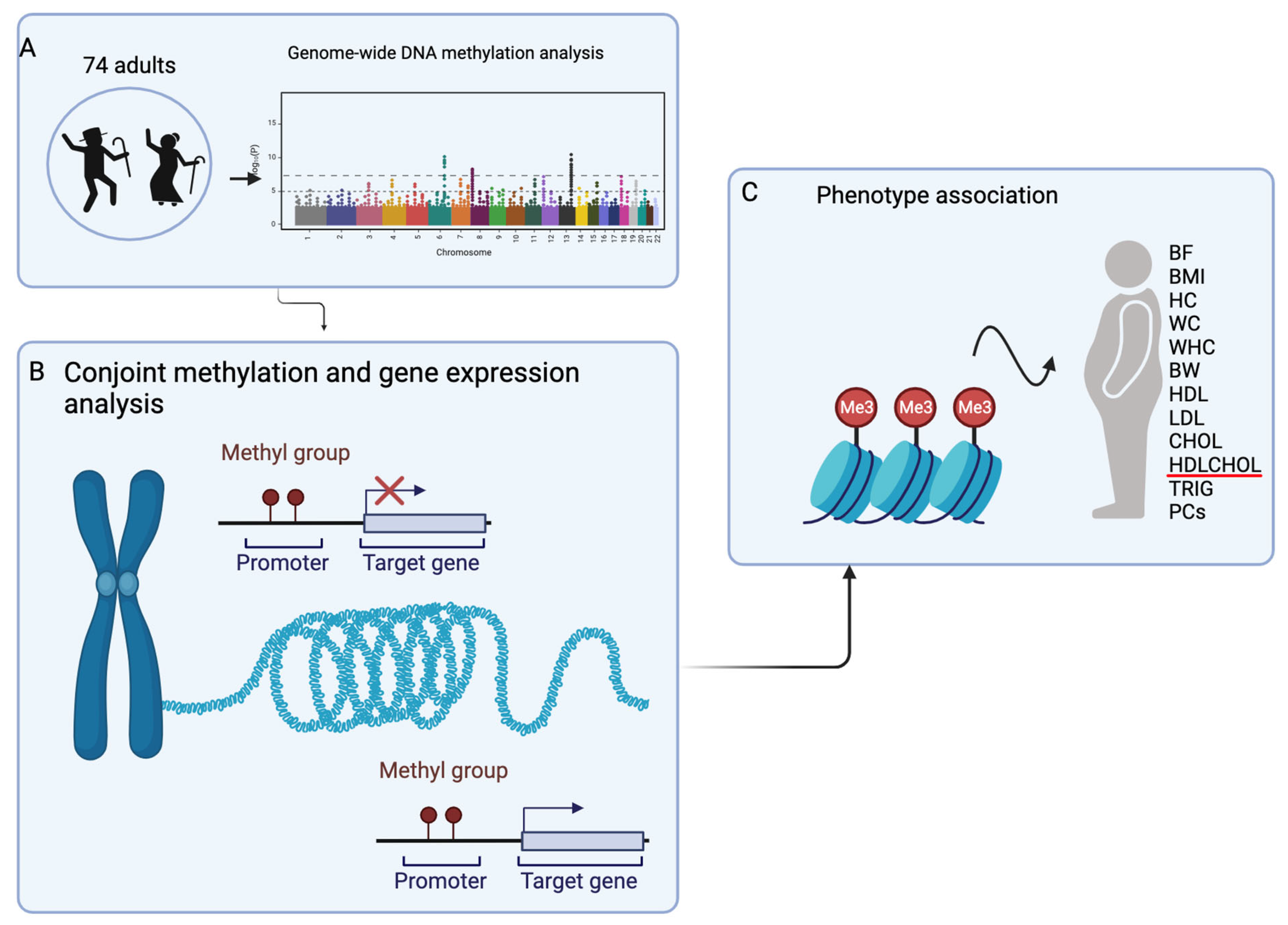
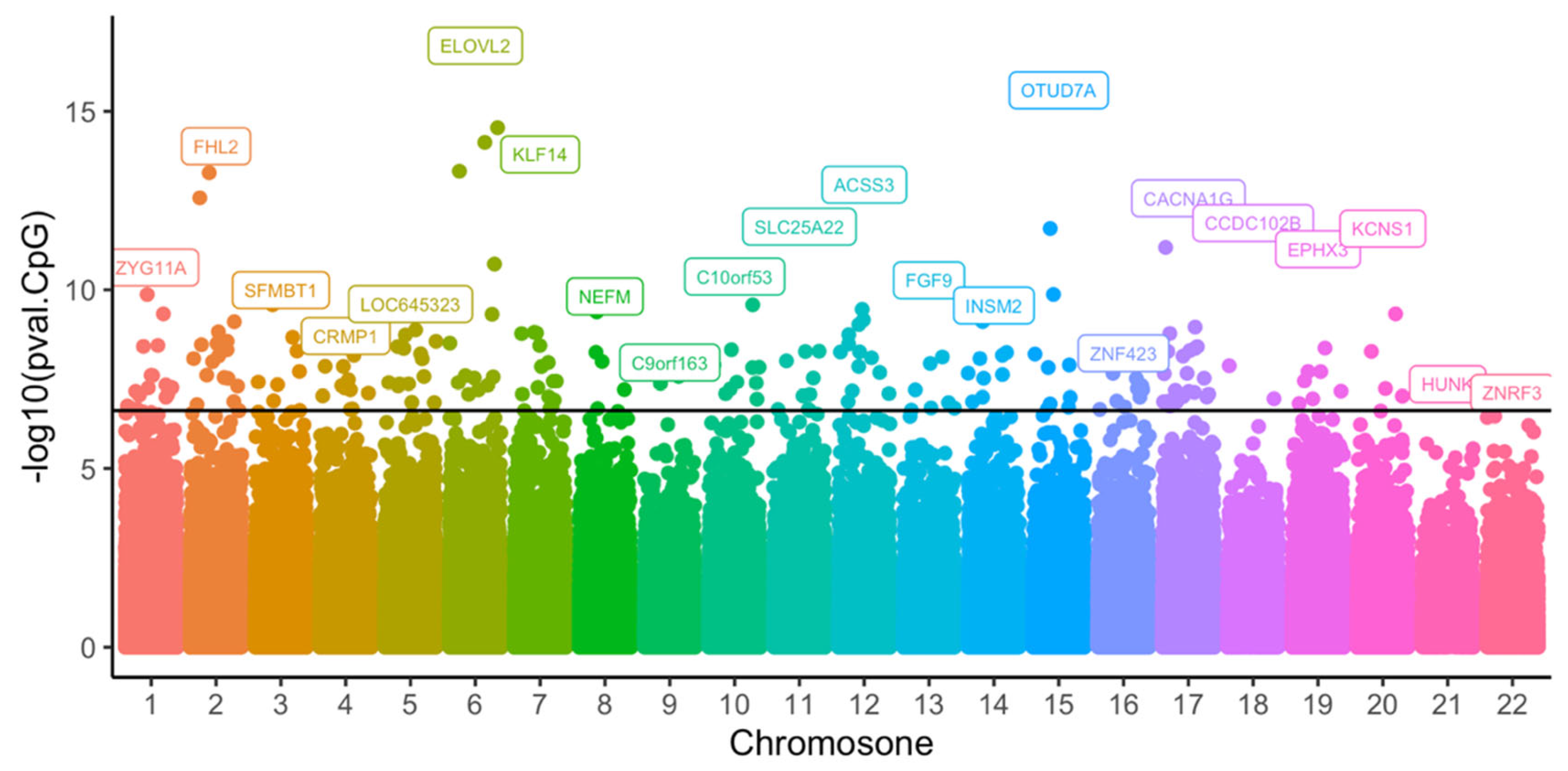
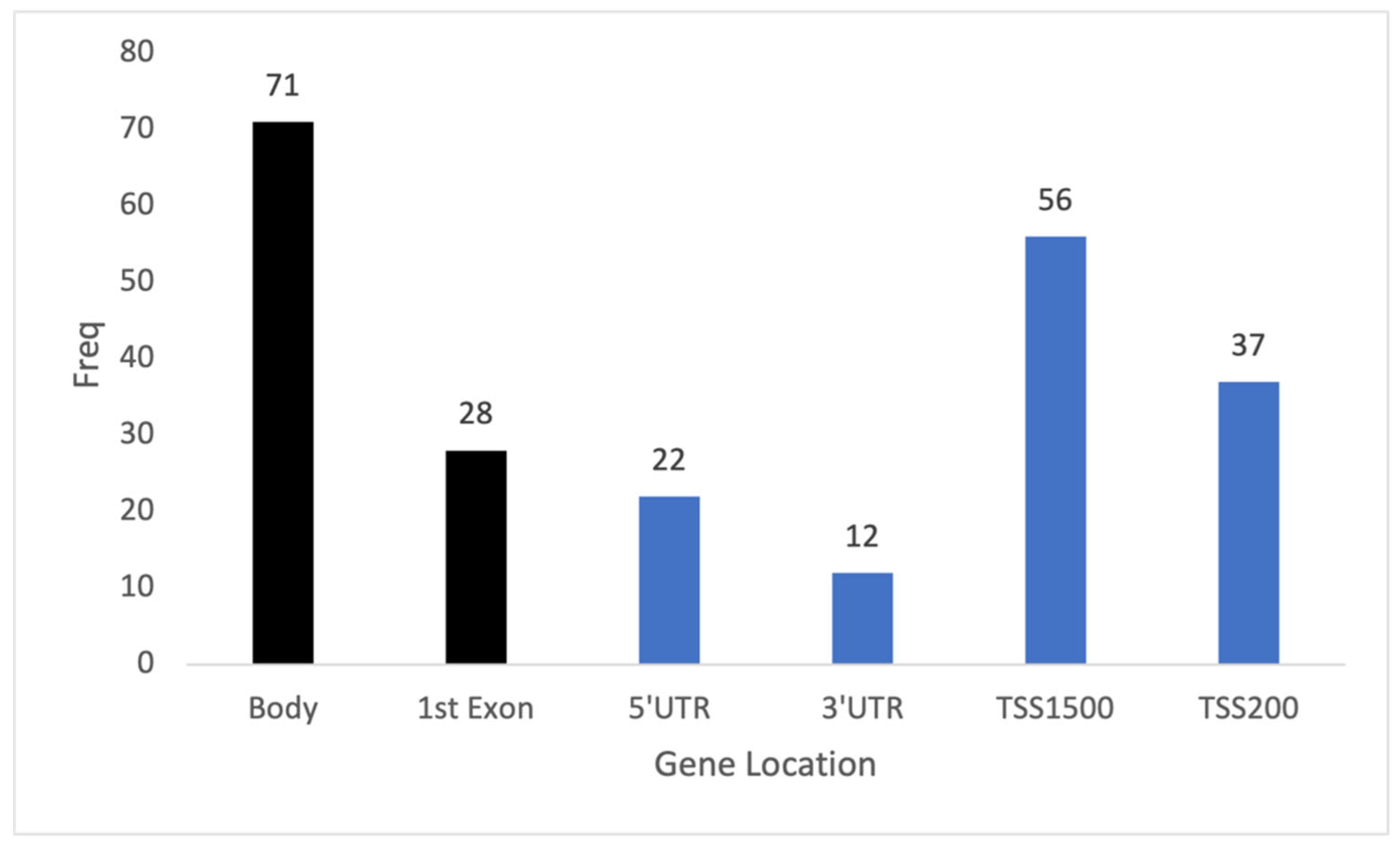
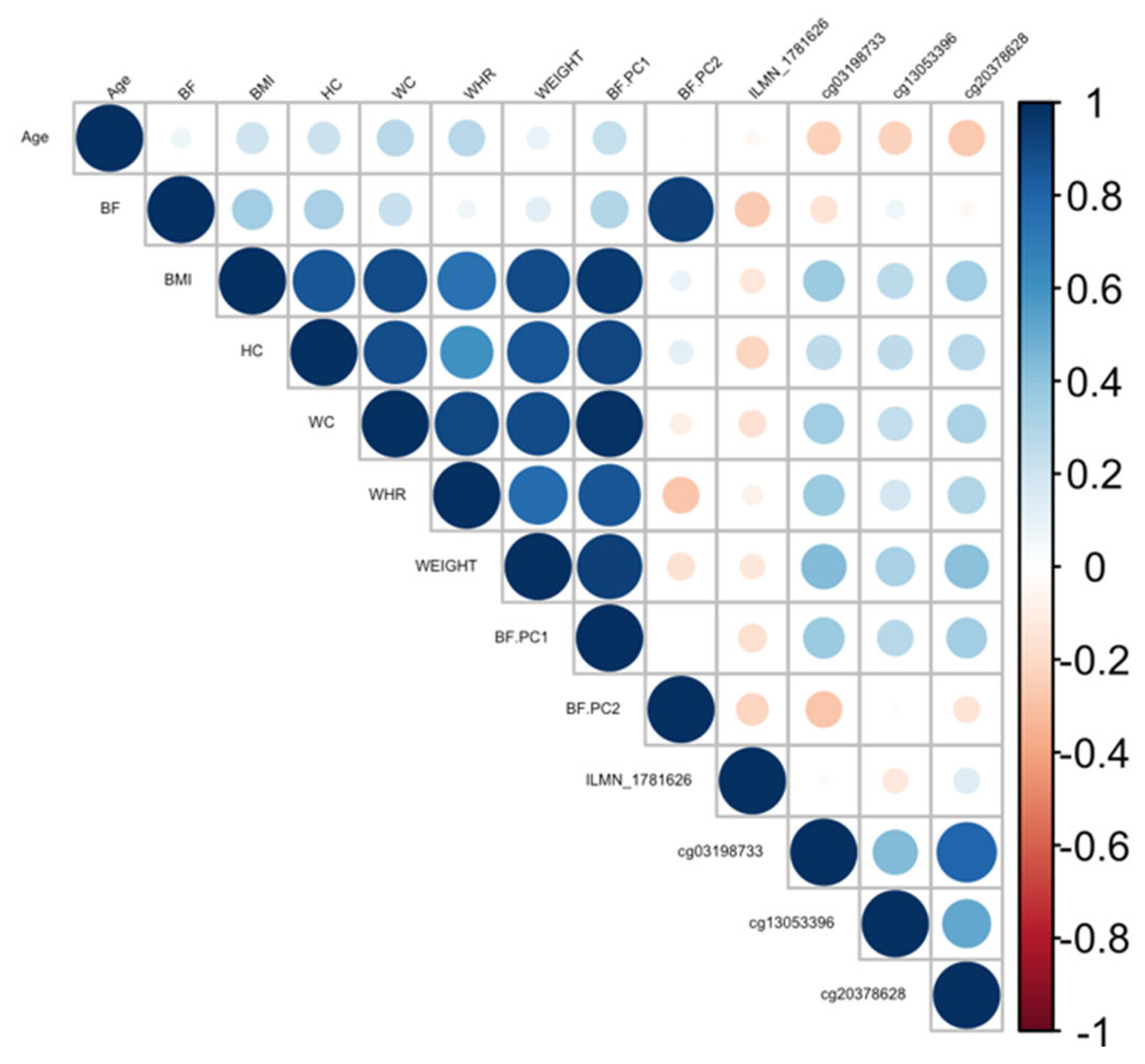
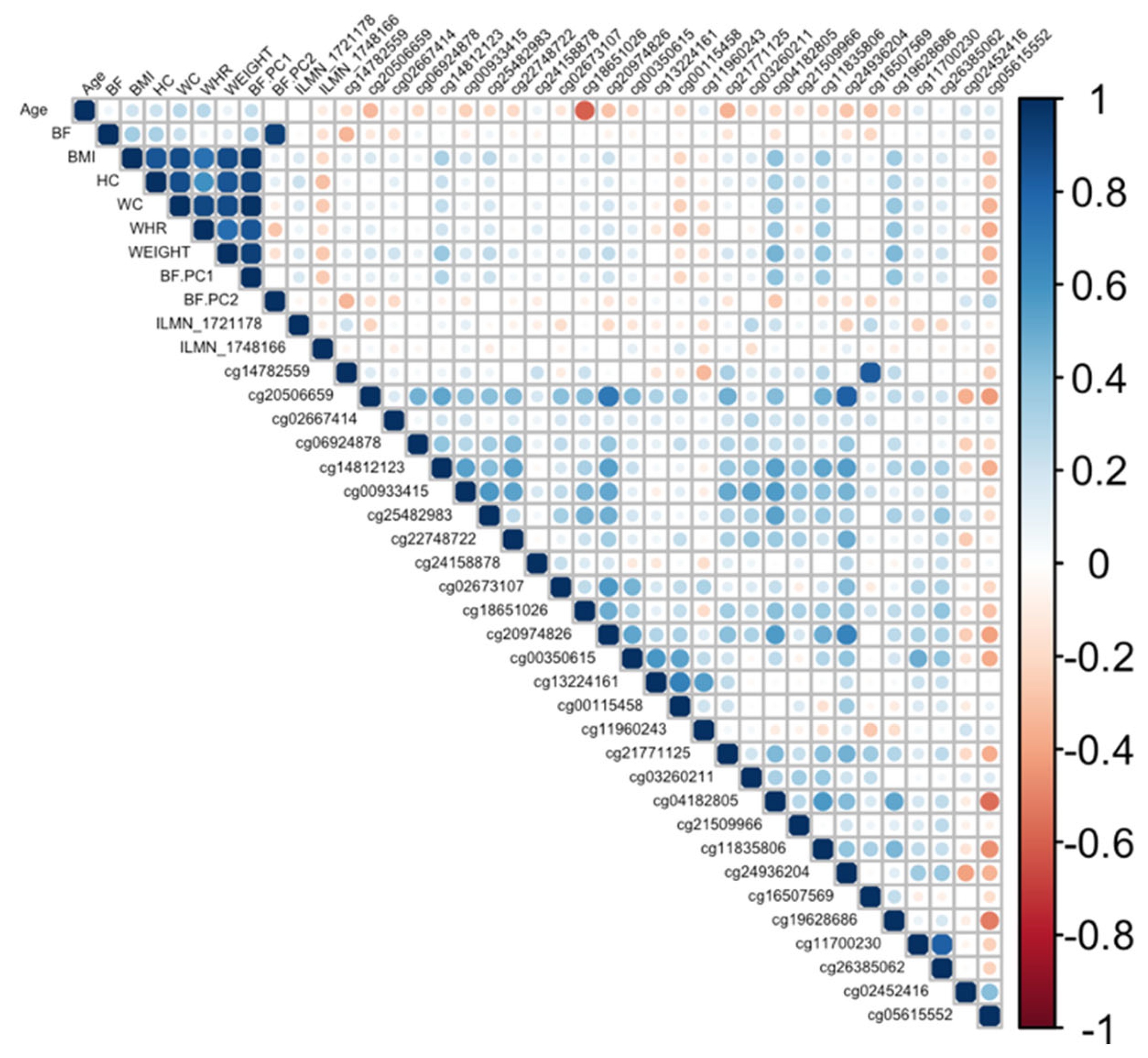
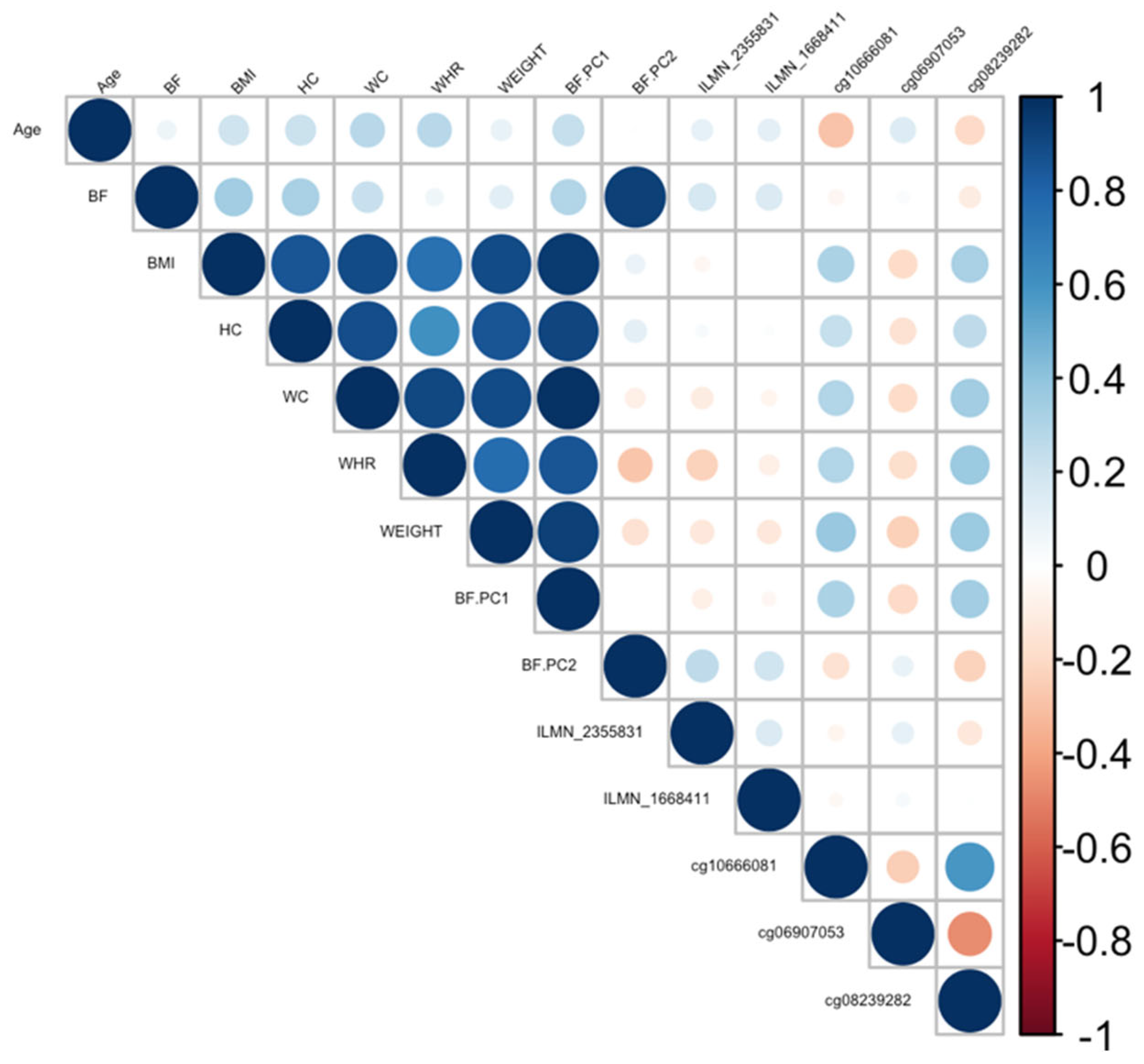
| Female (N = 24) | Male (N = 50) | Total (N = 74) | p | |
|---|---|---|---|---|
| Age | 51 (12.8) | 52.3 (12.1) | 51.9 (12.2) | 0.6 |
| Body Fat Percentage (%) | 34.1 (5.3) | 25.4 (7.8) | 28.2 (8.1) | <0.001 * |
| Body Mass Index (kg/m2) | 23.3 (2.3) | 27.9 (4.3) | 26.4 (4.3) | <0.001 * |
| Hip Circumference (cm) | 98.2 (6.1) | 105.9 (8.1) | 103.4 (8.3) | <0.001 * |
| Waist Circumference (cm) | 81.3 (9.4) | 99.1 (12.8) | 93.3 (14.4) | <0.001 * |
| Waist-to-Hip Ratio | 0.8 (0.06) | 0.9 (0.1) | 0.9 (0.1) | <0.001 * |
| Body Weight (kg) | 63.3 (7.67) | 89.36 (14.6) | 81 (17.7) | <0.001 * |
| Total Cholesterol (mmol/L) | 5.6 (0.85) | 5.71 (1.01) | 5.7 (0.96) | 0.586 |
| HDL-to-CHOL ratio (HDLCHOL) | 3.4 (0.74) | 4.53 (1.57) | 4.15 (1.46) | <0.001 * |
| Low Density Lipoprotein (mmol/L) | 3.4 (0.77) | 3.68 (0.98) | 3.6 (0.9) | 0.24 |
| High Density Lipoprotein (mmol/L) | 1.7 (0.33) | 1.37 (0.4) | 1.48 (0.41) | <0.001 * |
| Triglycerides (mmol/L) | 1.01 (0.35) | 1.68 (1.7) | 1.47 (1.45) | 0.063 |
| CpG | Beta | p | R2 | CHR | MAPINFO | Gene | Feature |
|---|---|---|---|---|---|---|---|
| cg16867657 | 0.8 | 1.4 × 10−17 | 0.64 | 6 | 11044877 | ELOVL2 | TSS1500 |
| cg04875128 | 0.78 | 2.6 × 10−16 | 0.61 | 15 | 31775895 | OTUD7A | Body |
| cg22736354 | 0.76 | 2.9 × 10−15 | 0.58 | 6 | 18122719 | NHLRC1 | 1stExon |
| cg22454769 | 0.75 | 1.1 × 10−14 | 0.57 | 2 | 106015767 | FHL2 | TSS200 |
| cg24079702 | 0.75 | 9.5 × 10−15 | 0.57 | 2 | 106015771 | FHL2 | TSS200 |
| cg24724428 | 0.76 | 7.4 × 10−15 | 0.57 | 6 | 11044888 | ELOVL2 | TSS1500 |
| cg14361627 | 0.75 | 1.6 × 10−14 | 0.56 | 7 | 130419116 | KLF14 | TSS1500 |
| cg23606718 | 0.74 | 5.3 × 10−14 | 0.55 | 2 | 131513927 | FAM123C | 5′UTR |
| cg21572722 | 0.74 | 4.7 × 10−14 | 0.55 | 6 | 11044894 | ELOVL2 | TSS1500 |
| cg11649376 | −0.73 | 1.1 × 10−13 | 0.54 | 12 | 81473234 | ACSS3 | Body |
| CpG | Transcript | CpG | Transcript | CpG × Transcript | R2 | CHR | Position | Gene | Feature | R a | Known b | |||
|---|---|---|---|---|---|---|---|---|---|---|---|---|---|---|
| Beta | p | Beta | p | Beta | p | |||||||||
| cg18651026 | ILMN_1748166 | 5.35 | 4.30 × 10−2 | 3.16 | 2.90 × 10−2 | −6.87 | 2.50 × 10−2 | 0.4 | 6 | 33140660 | COL11A2 | Body | 0.04 | 1 |
| cg00743094 | ILMN_1663538 | −3.09 | 4.30 × 10−2 | −1.21 | 7.30 × 10−3 | 3.9 | 1.70 × 10−2 | 0.39 | 13 | 100547968 | CLYBL | 3′UTR | 0.09 | 0 |
| cg11872672 | ILMN_1728844 | −7.36 | 2.60 × 10−2 | −5.7 | 3.70 × 10−2 | 7.75 | 3.90 × 10−2 | 0.36 | 7 | 157514730 | PTPRN2 | Body | −0.23 | 0 |
| cg13096208 | ILMN_1855910 | 9.05 | 4.60 × 10−3 | 1.49 | 3.10 × 10−3 | −8.63 | 6.40 × 10−3 | 0.24 | 18 | 55019843 | ST8SIA3 | 1stExon | −0.11 | 0 |
| cg05638739 | ILMN_1690465 | −10.44 | 4.40× 10−5 | −12.94 | 5.40× 10−5 | 18 | 5.30× 10−5 | 0.22 | 16 | 89440324 | ANKRD11 | 5′UTR | 0.19 | 0 |
| cg23095192 | ILMN_1820767 | −8.89 | 1.90 × 10−2 | −3.94 | 3.20 × 10−2 | 8.89 | 2.20 × 10−2 | 0.2 | 2 | 145271307 | ZEB2 | Body | −0.19 | 0 |
| cg20332195 | ILMN_1682449 | −10.72 | 9.20 × 10−3 | −2.15 | 9.00 × 10−3 | 11.19 | 7.30 × 10−3 | 0.2 | 4 | 10459929 | ZNF518B | TSS1500 | −0.04 | 0 |
| cg06799422 | ILMN_2372379 | 7.08 | 1.70 × 10−2 | 1.54 | 1.70 × 10−2 | −7 | 2.30 × 10−2 | 0.19 | 15 | 41952235 | MGA | TSS1500 | 0.07 | 1 |
| cg22088743 | ILMN_2133675 | 9.56 | 4.70 × 10−3 | 16.9 | 3.50 × 10−3 | −18.97 | 3.70 × 10−3 | 0.19 | 17 | 78183317 | SGSH | 3′UTR | −0.06 | 0 |
| cg10666081 | ILMN_2355831 | −6.92 | 8.40 × 10−3 | −12.79 | 1.20 × 10−2 | 14.17 | 1.10 × 10−2 | 0.17 | 2 | 105985002 | FHL2 | Body | −0.05 | 0 |
| cg17761990 | ILMN_2391750 | 8.32 | 1.40 × 10−3 | 14.69 | 1.00 × 10−3 | −17.13 | 1.10 × 10−3 | 0.17 | 3 | 53042940 | SFMBT1 | 5′UTR | 0.03 | 0 |
| cg07198402 | ILMN_1749667 | 8.69 | 2.40 × 10−2 | 10.48 | 2.00 × 10−2 | −14.3 | 2.00 × 10−2 | 0.17 | 1 | 228395145 | OBSCN | TSS1500 | 0.07 | 0 |
| cg14082919 | ILMN_2352295 | 11.16 | 8.20 × 10−3 | 14.14 | 7.30 × 10−3 | −16.69 | 6.80 × 10−3 | 0.17 | 11 | 129814820 | PRDM10 | Body | −0.17 | 0 |
| cg18443378 | ILMN_1746552 | −5.65 | 4.20 × 10−2 | −1.52 | 3.10 × 10−2 | 6.09 | 3.20 × 10−2 | 0.16 | 4 | 176986950 | WDR17 | TSS200 | −0.04 | 0 |
| cg04662983 | ILMN_1708508 | −9.33 | 6.80 × 10−3 | −1.88 | 3.20 × 10−3 | 9.43 | 5.80 × 10−3 | 0.16 | 17 | 56834321 | PPM1E | Body | −0.14 | 0 |
| cg20671534 | ILMN_1658576 | −6.04 | 6.50 × 10−3 | −2.56 | 1.20 × 10−2 | 6.65 | 8.80 × 10−3 | 0.15 | 2 | 220174629 | PTPRN | TSS1500 | 0.12 | 0 |
| cg13053396 | ILMN_1781626 | −10.19 | 4.50 × 10−3 | −8.53 | 5.10 × 10−3 | 12.23 | 5.40 × 10−3 | 0.15 | 12 | 7168545 | C1S | 5′UTR | −0.13 | 0 |
| cg16765387 | ILMN_1719975 | −5.3 | 7.10 × 10−4 | −3.14 | 8.30 × 10−4 | 5.9 | 7.20 × 10−4 | 0.15 | 12 | 54411245 | HOXC4 | 5′UTR | −0.09 | 0 |
| cg19929852 | ILMN_1774948 | 9.08 | 1.00 × 10−2 | 13.15 | 8.60 × 10−3 | −15.21 | 9.60 × 10−3 | 0.14 | 4 | 15068643 | CPEB2 | 3′UTR | −0.08 | 0 |
| cg02764478 | ILMN_1696279 | 6.66 | 3.70 × 10−2 | 1.85 | 4.90 × 10−2 | −6.46 | 4.50 × 10−2 | 0.14 | 6 | 100904316 | SIM1 | Body | −0.1 | 1 |
| cg19262958 | ILMN_1687958 | 4.49 | 4.80 × 10−2 | 8.21 | 4.20 × 10−2 | −9.57 | 3.80 × 10−2 | 0.14 | 11 | 792861 | SLC25A22 | Body | −0.02 | 0 |
| cg26365090 | ILMN_2082209 | −10.07 | 1.20 × 10−2 | −0.55 | 2.70 × 10−3 | 10.11 | 1.30 × 10−2 | 0.13 | 20 | 42574362 | TOX2 | 5′UTR | 0.21 | 0 |
| cg13539203 | ILMN_1768483 | 9.55 | 7.80 × 10−3 | 10.02 | 7.80 × 10−3 | −14.08 | 7.10 × 10−3 | 0.12 | 2 | 26950545 | KCNK3 | Body | 0.01 | 0 |
| cg08858926 | ILMN_1808587 | −7.5 | 8.90 × 10−3 | −3.74 | 1.20 × 10−2 | 7.97 | 1.00 × 10−2 | 0.12 | 16 | 72918832 | ZFHX3 | Body | −0.09 | 0 |
| cg22743761 | ILMN_1739366 | −5.7 | 3.20 × 10−2 | −2.22 | 2.70 × 10−2 | 6.85 | 2.60 × 10−2 | 0.11 | 2 | 162273648 | TBR1 | Body | 0.26 | 0 |
| cg17949162 | ILMN_1796855 | 13.11 | 1.60 × 10−2 | 1.51 | 9.10 × 10−3 | −13.17 | 1.70 × 10−2 | 0.11 | 10 | 121355153 | TIAL1 | Body | 0.03 | 0 |
| cg04256697 | ILMN_1684440 | 5.15 | 1.30 × 10−2 | 3.05 | 8.50 × 10−3 | −6.22 | 1.20 × 10−2 | 0.11 | 12 | 120688557 | PXN | Body | 0.1 | 0 |
| cg10912240 | ILMN_2149946 | −5.43 | 3.20 × 10−2 | −1.76 | 2.40 × 10−2 | 5.99 | 2.60 × 10−2 | 0.11 | 14 | 29235907 | FOXG1 | TSS1500 | 0.06 | 1 |
| cg00866814 | ILMN_1668194 | −5.78 | 7.00 × 10−3 | −2.98 | 9.10 × 10−3 | 6.46 | 8.40 × 10−3 | 0.11 | 19 | 49017364 | LMTK3 | TSS1500 | 0.03 | 0 |
| cg09628707 | ILMN_1761903 | 7.53 | 8.70 × 10−3 | 3.09 | 9.00 × 10−3 | −7.86 | 9.70 × 10−3 | 0.11 | 20 | 43729410 | KCNS1 | 5′UTR | −0.05 | 0 |
| cg17370322 | ILMN_1788457 | 7.85 | 1.40 × 10−2 | 0.88 | 7.80 × 10−3 | −7.95 | 1.50 × 10−2 | 0.1 | 13 | 95953482 | ABCC4 | Body | 0.16 | 0 |
| cg03578473 | ILMN_1669425 | −9.72 | 1.30 × 10−2 | −1.15 | 1.30 × 10−2 | 9.9 | 1.20 × 10−2 | 0.09 | 2 | 182546504 | NEUROD1 | TSS1500 | 0.05 | 0 |
| cg22509041 | ILMN_2119692 | 5.42 | 4.10 × 10−2 | 1.18 | 2.40 × 10−2 | −5.6 | 4.30 × 10−2 | 0.09 | 12 | 53574524 | CSAD | TSS200 | 0.15 | 0 |
| cg11718501 | ILMN_1666310 | 5.18 | 4.20 × 10−2 | 1.13 | 2.30 × 10−2 | −5.09 | 4.10 × 10−2 | 0.08 | 11 | 122850972 | BSX | Body | −0.21 | 0 |
| cg08198377 | ILMN_1691181 | −3.6 | 2.70 × 10−2 | −1.84 | 3.20 × 10−2 | 3.62 | 2.80 × 10−2 | 0.07 | 14 | 51707975 | TMX1 | Body | −0.24 | 0 |
| Phenotype | CpG | CHR | MAPINFO | Gene | Feature | Beta | p | R2 |
|---|---|---|---|---|---|---|---|---|
| BF | cg10666081 | 2 | 105985002 | FHL2 | Body | 0.25 | 3.5 × 10−2 | 0.31 |
| HC | cg20671534 | 2 | 220174629 | PTPRN | TSS1500 | 0.25 | 2.4 × 10−2 | 0.29 |
| BF | cg19929852 | 4 | 15068643 | CPEB2 | 3′UTR | −0.3 | 3.6 × 10−3 | 0.35 |
| BMI | −0.27 | 9.9 × 10−3 | 0.35 | |||||
| BW | −0.21 | 1.5 × 10−2 | 0.53 | |||||
| HC | −0.24 | 2.6 × 10−2 | 0.29 | |||||
| BF.PC1 | −0.23 | 1.8 × 10−2 | 0.41 | |||||
| BF.PC2 | −0.26 | 2.7 × 10−3 | 0.56 | |||||
| WC | cg18651026 | 6 | 33140660 | COL11A2 | Body | 0.28 | 1.9 × 10−2 | 0.44 |
| WHR | 0.28 | 1.3 × 10−2 | 0.50 | |||||
| BF.PC1 | 0.26 | 3.5 × 10−2 | 0.40 | |||||
| BF | cg17949162 | 10 | 121355153 | TIAL1 | Body | 0.41 | 6.1 × 10−4 | 0.38 |
| BMI | 0.45 | 1.0 × 10−4 | 0.43 | |||||
| BW | 0.29 | 3.9 × 10−3 | 0.55 | |||||
| HC | 0.32 | 9.2 × 10−3 | 0.30 | |||||
| WC | 0.39 | 2.7 × 10−4 | 0.50 | |||||
| WHR | 0.35 | 6.8 × 10−4 | 0.54 | |||||
| BF.PC1 | 0.41 | 2.1 × 10−4 | 0.47 | |||||
| BF.PC2 | 0.28 | 5.1 × 10−3 | 0.55 | |||||
| BF | cg11718501 | 11 | 122850972 | BSX | Body | −0.29 | 2.3 × 10−2 | 0.32 |
| WHR | −0.23 | 4.2 × 10−2 | 0.48 | |||||
| BF.PC2 | −0.21 | 4.9 × 10−2 | 0.53 | |||||
| BMI | cg13053396 | 12 | 7168545 | C1S | 5′UTR | 0.24 | 2.1 × 10−2 | 0.34 |
| BW | 0.24 | 6.3 × 10−3 | 0.54 | |||||
| HC | 0.25 | 2.2 × 10−2 | 0.29 | |||||
| WC | 0.22 | 2.2 × 10−2 | 0.44 | |||||
| BF.PC1 | 0.25 | 1.3 × 10−2 | 0.41 | |||||
| BF | cg05638739 | 16 | 89440324 | ANKRD11 | 5′UTR | 0.27 | 1.3 × 10−2 | 0.33 |
| BMI | 0.34 | 1.7 × 10−3 | 0.38 | |||||
| BW | 0.21 | 2.4 × 10−2 | 0.52 | |||||
| HC | 0.25 | 3.0 × 10−2 | 0.28 | |||||
| WC | 0.24 | 1.8 × 10−2 | 0.45 | |||||
| HDL | −0.23 | 4.9 × 10−2 | 0.20 | |||||
| CHOLHDL | 0.24 | 4.6 × 10−2 | 0.22 | |||||
| BF.PC1 | 0.27 | 7.7 × 10−3 | 0.42 | |||||
| BF.PC2 | 0.21 | 2.2 × 10−2 | 0.53 | |||||
| BMI | cg26365090 | 20 | 42574362 | TOX2 | 5′UTR | −0.21 | 4.1 × 10−2 | 0.33 |
| BW | cg09628707 | 20 | 43729410 | KCNS1 | 5′UTR | 0.18 | 3.9 × 10−2 | 0.52 |
Disclaimer/Publisher’s Note: The statements, opinions and data contained in all publications are solely those of the individual author(s) and contributor(s) and not of MDPI and/or the editor(s). MDPI and/or the editor(s) disclaim responsibility for any injury to people or property resulting from any ideas, methods, instructions or products referred to in the content. |
© 2023 by the authors. Licensee MDPI, Basel, Switzerland. This article is an open access article distributed under the terms and conditions of the Creative Commons Attribution (CC BY) license (https://creativecommons.org/licenses/by/4.0/).
Share and Cite
Cao, T.V.; Sutherland, H.G.; Benton, M.C.; Haupt, L.M.; Lea, R.A.; Griffiths, L.R. Exploring the Functional Basis of Epigenetic Aging in Relation to Body Fat Phenotypes in the Norfolk Island Cohort. Curr. Issues Mol. Biol. 2023, 45, 7862-7877. https://doi.org/10.3390/cimb45100497
Cao TV, Sutherland HG, Benton MC, Haupt LM, Lea RA, Griffiths LR. Exploring the Functional Basis of Epigenetic Aging in Relation to Body Fat Phenotypes in the Norfolk Island Cohort. Current Issues in Molecular Biology. 2023; 45(10):7862-7877. https://doi.org/10.3390/cimb45100497
Chicago/Turabian StyleCao, Thao Van, Heidi G. Sutherland, Miles C. Benton, Larisa M. Haupt, Rodney A. Lea, and Lyn R. Griffiths. 2023. "Exploring the Functional Basis of Epigenetic Aging in Relation to Body Fat Phenotypes in the Norfolk Island Cohort" Current Issues in Molecular Biology 45, no. 10: 7862-7877. https://doi.org/10.3390/cimb45100497
APA StyleCao, T. V., Sutherland, H. G., Benton, M. C., Haupt, L. M., Lea, R. A., & Griffiths, L. R. (2023). Exploring the Functional Basis of Epigenetic Aging in Relation to Body Fat Phenotypes in the Norfolk Island Cohort. Current Issues in Molecular Biology, 45(10), 7862-7877. https://doi.org/10.3390/cimb45100497







